#Adam Stokowski
Text
Fantasia 2000 at 34
A review by Adam D. Jaspering
Walt Disney was an ambitious man. He was always big on ideas, trying to push the boundaries of what was possible. He did many amazing things in his life. He wanted to do even more. But even for a man as powerful as Disney, ambitions weren’t always feasible.
The annoying counterpart to ambition is reality. There are always obstacles, and sometimes those impediments are insurmountable. Sometimes ambitions need to be scaled back until the final product is a shadow of the original idea. Such was the case with Fantasia.
Fantasia was conceived as an ongoing, evolving anthology. Every time audiences saw the picture, it would be different. The movie would be continuously re-released with new animated shorts and new music. Certain segments would be retired, while others would be kept. It would be a mixture of new, old, and classic material, spanning eras.
But Fantasia’s 1940 release was a disaster. Production costs were swollen, American moviegoers were lukewarm on the film, and World War II made a European release impossible. It cost too much and earned too little. All future plans for Fantasia were scrapped. The film was simply too high-concept for its own good.
But an idea infeasible in one era doesn’t mean the idea is infeasible in all eras. Leonardo Da Vinci designed the first helicopter in 1493, 446 years before the first helicopter was built. Likewise, a sequel to Fantasia was infeasible in the 1940s, but one finally came to fruition 60 years later.

Fantasia is more than just cartoons set to music. It’s a theatrical experience. Fantasia was the first commercial film presented in stereo. Specifically, it was presented in “Fantasound,” an early version of stereophonic surround sound. Since theaters of the era were unequipped with the necessary speaker systems, Fantasia was presented as a road show. It played in individual theaters, one at a time. Crews literally installed the Fantasound speaker system before each booking. Afterwards, they dismantled it and and moved it to the next theater.

Fantasia 2000 had a similar limited release, utilizing its own emerging cinematic technology. Specifically, the IMAX film format. Invented in 1970, IMAX uses an oversized 70mm film stock. The giant-sized celluloid produces an image nine times larger than conventional 35mm filmstock It’s three times larger than other 70mm formats, such as Cinemascope and VistaVision.
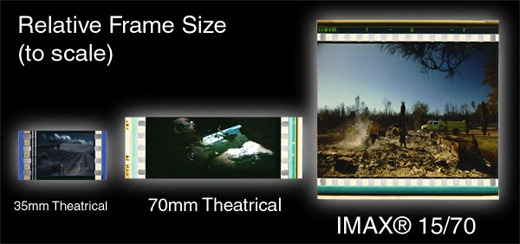
Today, IMAX has done away with the enormous film reels, presenting fully digitally. What’s more, IMAX is frequently used a brand name for any oversized projection. It’s not uncommon for modern IMAX screens to be less than a quarter the size of true IMAX.
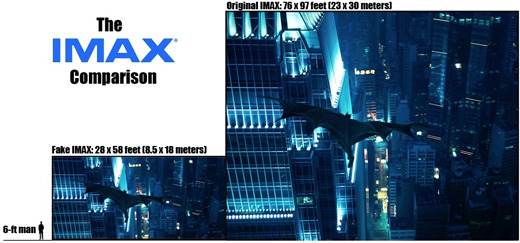
In 2000, there were only 205 IMAX theaters worldwide. Disney released Fantasia 2000 in 75 of these theaters between January and April 2000. These early IMAX screens often struggled to find features. A good percent were located in museums, exclusively screening documentaries. Any programming, even risky ventures, were welcomed.
The opening moments of Fantasia 2000 acknowledges its place as a follow-up to a legacy. Scenes from the original movie soar over the orchestra, refamiliarizing the audience. These floating sheets play brief snippets of the classic shorts while the musicians warm up. Memories are conjured and emotions are ignited. Nostalgia is a key role in setting the mood.

Stylistically, things are different. Gone are the shrouded musicians cloaked in darkness. Instead, things are bright, illuminated, and crisp. The music is no longer the primary subject; deprivation and mystery won’t benefit the film. The focus of Fantasia 2000 is the spectacle. Disney wants their orchestra seen and appreciated.
This time around, the majority of the music is performed by the Chicago Symphony Orchestra, and conducted by James Levine. The exceptions are The Sorcerer’s Apprentice, which uses the archival music from 1940, performed by an ad hoc ensemble of Los Angeles musicians, conducted by Leopold Stokowski. The other segment is Rhapsody in Blue, performed by London-based Philharmonia Orchestra, conducted by Bruce Broughton. Rhapsody in Blue was a late addition to the film; the original Fantasia 2000 performers could not be reassembled in time for its performance. They do perform Rhapsody in Blue on the film’s soundtrack.
The original film featured Deems Taylor, an esteemed music critic of the era, as the emcee. He was tasked with introducing each segment and providing background to each short. It gave the film an anchor and a voice. It gave the film a sense of authenticity, clueing in the audience to the curated secrets; what was onscreen, and why.
Fantasia 2000 lets their segments (mostly) speak for themselves. In lieu of an expert on classical music, a bevy of celebrities introduce each segment. Stars from stage and screen drop in, offering a variety of takes.

A few of these celebrities contribute in the film’s favor. Violinist Itzhak Perlman seems quite knowledgeable. As does music producer Quincy Jones. Actress Angela Lansbury takes her role seriously and with gravitas. But the others, not so much.
Actor James Earl Jones musters all his thespian might, but he has been tasked by the writers to do nothing but recite a flat joke. Magician duo Penn and Teller go on a long tangent about illusions that loses sight of their original point. Singer/actress Bette Midler has an odd, slightly insulting tone when she discusses segments cut from the final film. And comedian Steve Martin just ruins everything.
Martin delivers an unwelcome bit of schtick, feebly trying to play a violin at the film’s onset. The camera pans away from him, scanning the orchestra, desperate to focus attention elsewhere. You can feel the pain and torture of each musician, forced to sit in uncomfortable silence as Martin continues hamming things up off-camera.
It’s obvious, these celebrity introductions were done to attract audiences. Disney could put A-list names on posters and press releases, stirring interest. In execution, they do nothing in the film’s favor. It was a failed attempt to court a disinterested market, but more on that later.
The first segment of the film is Beethoven’s Fifth Symphony. Widely considered the most iconic and recognizable work in all classical music, there’s no better choice to begin the film. The four-note opening bar can be identified by people from all walks of life.

The segment features a bunch of abstract butterflies. Nothing more than two triangles each, they look more like origami than insects. The creatures swarm and swoop across a variety of vivaciously colored landscapes.

The opening is a parallel to the opening of the original Fantasia. The original used non-representative forms and shapes to convey emotion and feeling. Here, geometry and motion fulfill the same purpose. The difference being, instead of pure abstraction, it’s constructivist. They’re clearly supposed to be butterflies, just drawn in a very unique way.
The butterflies are trying to convey a narrative about a chase. Something exciting, something perilous, and something invigorating. Which undermines the animation style. Is it supposed to be abstract, or literal? The film can’t decide. It’s too underdeveloped to be a full-on story, but too overdeveloped to be ethereal. It’s confusing, but at least it’s short. If you can’t think of anything interesting to say, say it quickly and look nice doing it.
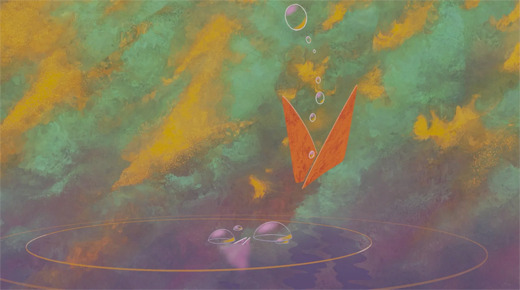
Segment two is Respighi’s Pines of Rome. It features a pod of whales, soaring majestically through the sea, breaching the surf in a majestic dance. Things get surreal when the whales take to the sky, breaching the clouds in the very same way. Throughout, a young whale is separated from his parents, trying to rejoin them.
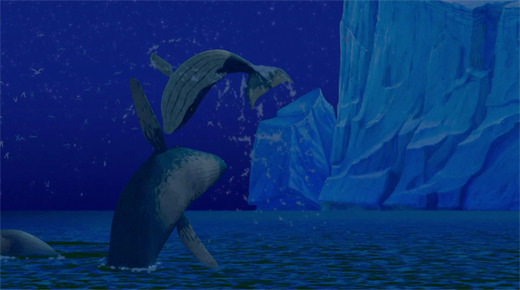
Again, the filmmakers have a strange idea about what Fantasia is and what a segment should be trying to accomplish. Just because visuals are matching the music, it doesn’t automatically make a fulfilled idea. Imagery and music are supposed to work in tandem to express a feeling. To convey an emotion. To share an idea. If it’s just a bunch of pretty pictures which happen to be set to music, it’s nothing more than a screensaver.
A segment can be a narrative, but that means it must have a definitive story with characters, struggles, and a resolution. Likewise, a segment can be a non-narrative, using forms to present nonliteral ideas and evocations. But don’t split the difference.
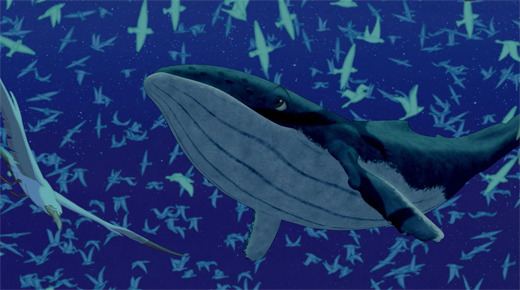
Nothing happening onscreen makes sense. Not in the ‘It’s experimental’ manner. Not in the ‘It’s open to interpretation’ manner. Not in the ‘It’s a dreamscape’ manner. But in the ‘I guess they’re over here doing this now, and I guess that’s unconnected from what was happening before’ manner.
Pines of Rome tries in vain to tell a story about a young whale not keeping in step with parents, somehow getting left behind. Along the way he somehow gets trapped in an iceberg, before somehow escaping. It’s not quite clear why any of this is happening, and it’s the second segment in a row that features a character being chased. There has to be something animators can put to fast-tempo music besides a chase scene.
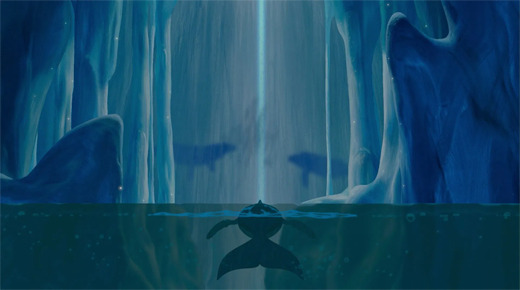
The aurora borealis is presented nicely, as are the star-draped sky, icebergs, and ocean water. If it were a ten minute segment of whales dancing in natural beauty, it would have been a wonderful segment. A baleen ballet. Instead, it’s a story about wanting to visit a star way off in the distance, getting to that star without any gravitational hindrances, then upon reaching that star, living life exactly as before the journey. Its a cryptic, baffling attempt at storytelling. But at least the whales look nice.

The third segment, George Gershwin’s Rhapsody in Blue, is a bit of a departure. The orchestral jazz piece stands in contrast to the other classical works. It’s from a different era and has been influenced by different styles. But the passionate instrumentation and symphonic panache makes it fit in beautifully among the classical music.
Inspired heavily by the artwork of Al Hirschfeld, Rhapsody in Blue paints a portrait of an idealized New York from the Jazz Age. Art deco style abounds. Progress and industry define the landscape. The city is alive with hustle and movement. Music and freedom of expression are key themes.
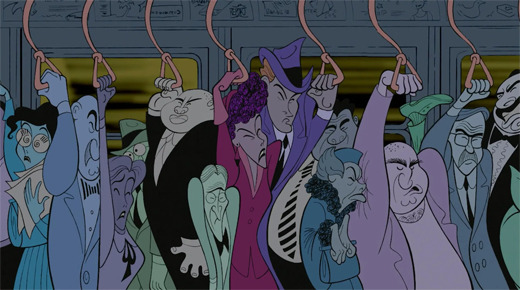
The segment presents four intersecting narratives. A construction worker resents his tedious job, wishing to pursue his dream of being a professional drummer. A wealthy man finds no joy in upper-class life, wanting to have fun and enjoy the simple things. An unemployed man with no money and no opportunities looks for any sort of break from his troubles. A young girl, ignored by her parents, is forced to participate in a gauntlet of classes she doesn’t care for.

Everything onscreen happens with great purpose. Every moment establishes mood, builds the environment, establishes character, or moves the stories. Every scene demonstrates the skills of the animators. Every scene has a clever joke. It’s impossible to be bored, and impossible to get lost.
The storylines bob and weave with great pace and great structure, never taking the limited scope for granted. We only focus on four characters, but we feel like it’s a city of five million. We see New York as a source of cold, sterile indifference. We also see it as a city of opportunity, passion, and fulfillment.

The four stories flow so naturally and smooth, never stepping on the others. All four flow well until their final culmination. All four fit succinctly and comfortably into a cartoon just under eight minutes. Rhapsody in Blue is without a doubt the highlight of Fantasia 2000.
Unfortunately, something has to follow. That misfortune goes to Shostakovich’s Piano Concerto No. 2. The fourth segment is an adaptation of the Hans Christian Andersen tale, The Steadfast Tin Soldier. The story involves a group of anthropomorphic toys. The titular tin soldier is damaged, having only leg. He falls in love with a porcelain ballerina, standing arabesque, whom he believes also has only one leg. But a malicious jack-in-the-box, jealous and scornful, interferes with their love.
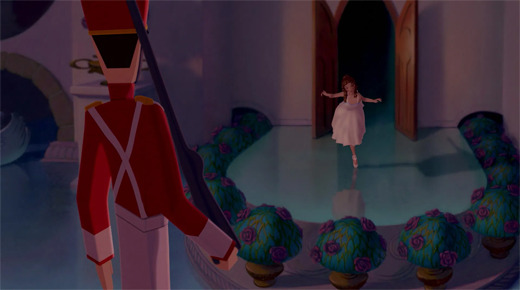
The story is fine. The segment is fine. The music is fine. There is nothing wholly wrong with this short. The idea of toys coming to life when no one’s looking is a staple of fantasy fiction. Andersen’s version of the fable was written in 1838.
But Disney produced this short a mere five years after Pixar Animation made the movie Toy Story. It was released two months after the sequel, Toy Story 2. Already bad luck, but Disney themselves distributed the films. They flooded the market themselves. Moviegoers had already seen and loved an entire movie with this concept. A short film based on antiquated material seems like a lesser version.
The animation is interesting. The three main characters are animated in CGI, but everything else is hand-drawn. Normally, the coarse turn-of-the-century CGI would be a strike against the film’s quality. Characters look blocky, the textures look flat, and the lighting looks off.
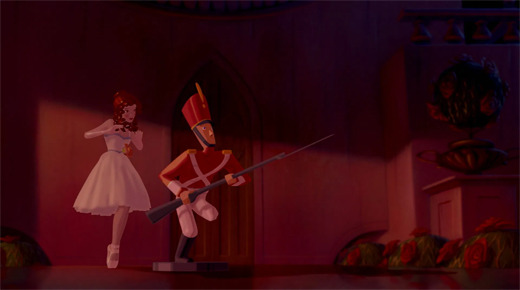
But in contrast against the detailed hand-drawn environment, the underwhelming CGI does the segment a small favor. The porcelain, tin, and wooden features of our main characters, in all their crudity, look emphasized. Because they look so garish, the eye is drawn to the foreground. Meanwhile, the rich details of the environment compensate for what’s underdeveloped.

Disney’s adaptation of The Steadfast Tin Soldier detours from Andersen’s original story. As is Disney’s modus operandi, the heroes get a happy ending at all costs. And there are costs. The entire story relies on a series of contrivances and coincidences. Some were present in the original Andersen tale. Some Disney provided. All will make eyes roll.
All together, the segment is hollow, feel-good treacle. If that’s not a deal-breaker, enjoy. For everyone else, it’s a segment that puts style ahead of substance.
Segment five is the strangest inclusion in the film. Set to the finale of Camille Saint-Saëns’s Carnival of the Animals, it’s a humorous escapade involving a flock of flamingoes. One of them bothers the rest with a yo-yo.
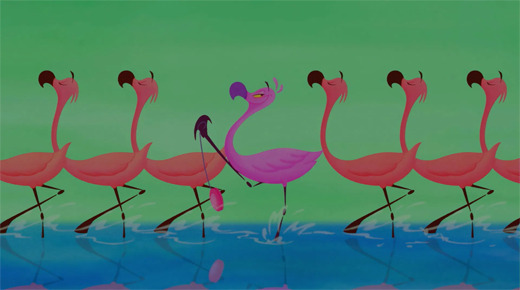
It’s clearly inspired by the original Fantasia’s Dance of the Hours sequence. Both segments feature a group of awkward animals performing an awkward ballet that turns chaotic. However, the flamingoes’ pratfalls are a far cry from the iconic dancing hippos and crocodiles.
Something about the procession seems inauthentic. The animators were trying too hard for the joke. They were desperate for laughs, and mugging for the audience was the easiest solution.

The segment is one brief idea that’s developed to its fullest capacity. The entire sequence is less than two minutes long, by far the shortest segment in either Fantasia film. It’s immediately forgettable.
Segment six is a reprise of Paul Dukas’s The Sorcerer’s Apprentice. A literal reprise. There’s no new performance by the symphony, and no new animation from Disney. It is literally the exact same segment from 1940. It’s even presented in fullscreen.
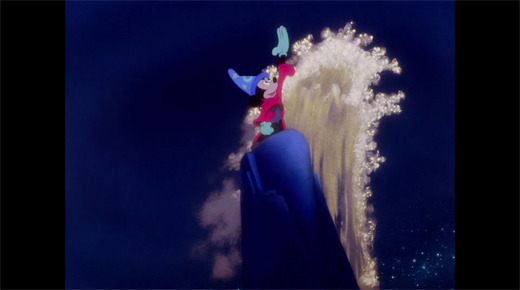
As mentioned, Fantasia was always intended to be an evolving project. New segments would be produced and swapped in, while old ones would find new audiences upon re-release. The Sorcerer’s Apprentice is the single most iconic element of Fantasia. Mickey Mouse in his wizard hat and the walking brooms are famous bits of Disney history. Their presence does more to stoke feelings of nostalgia and generate interest than a thousand celebrity hosts could.
Not including The Sorcerer’s Apprentice would be a mistake. It’s precisely what audiences want to see. Why deprive them of such a thing?
Sandwiching animation from the 1940s between cartoons from the 2000s provokes a sense of shock. Disney animation has an iconic look, but its easy to forget just how much that look evolved in sixty years’ time. The ink and paint of 40s-era Mickey Mouse looks sentimentally bygone next to the clean 00s-era computer graphics. Animation has come so far and made so much progress, leaving a long legacy in its wake.
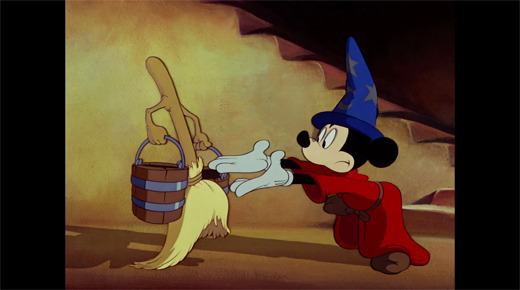
The Sorcerer’s Apprentice sketch ends just as it did in 1940. A silhouetted Mickey Mouse shakes the hand of conductor Leopold Stokowski. The film then transitions away from archival footage to an illuminated Mickey talking to conductor James Levine. Again, highlighting the branched legacy of both films, while acknowledging the advancements sixty years have brought.

Mickey Mouse sets the stage for Donald Duck, star of the seventh segment. Set to the music of Edward Elgar’s Pomp and Circumstance, Donald presents a very loose retelling of the Biblical story of Noah’s Ark. Donald plays Noah’s put-upon lackey, tasked with counting and corralling the animals. In a comedy of errors, both Donald and Daisy Duck believe the other missed the boat and were consumed by the flood.
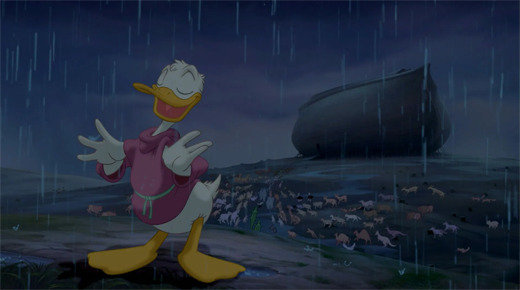
While Mickey Mouse has an air of dignity about him, even at the mercy of an army of enchanted brooms, Donald Duck has always been a broadly comedic character. And that’s precisely what he delivers in this segment. Donald is in over his head at every given point. Whether it’s trying to force a stubborn rhinoceros onto the boat, futilely trying to plug up leaks during a 40-day rainstorm, or stopping an incessant woodpecker, it’s all in service to the comedy. A golden bit of visual humor goes by quick, as Donald stares in confusion at a pair of non-humanoid ducks.
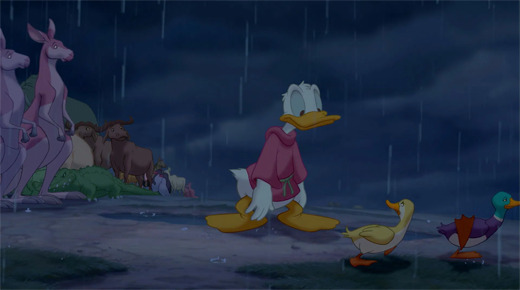
While the humor is great, it does illustrate the lack of sincerity and depth of someone like Donald Duck. You can’t have the angry, contentious Pekin treated like an affable punching bag for six minutes, then expect him to deliver pathos.
There are limits to what an audience wants and expects from certain characters. We barely associate Donald Duck with romance. We don’t associate him with grief. We definitely don’t associate him with Biblical epics. But that’s how Disney uses him, here. Whether he accomplishes his goals is subjective, but he was a dubious choice for such a project.

Using Pomp and Circumstance as the soundtrack is another odd decision. Fantasia’s mission was to avoid associated and stereotypical uses of classical pieces. It wanted the creative minds of animators to deliver what they saw and felt when listening to music. This is a noble approach for most classical pieces, a fool’s errand for others.
A work like Pomp and Circumstance is thoroughly ensconced in the public mind as the theme associated with graduations. It would take more than a Donald Duck cartoon to undo that connection. Whenever the animals walk in pair, one can’t help but think the buffalo just earned a bachelor’s degree. It was a noble effort on Disney’s part, but too ambitious with the tools they were using.
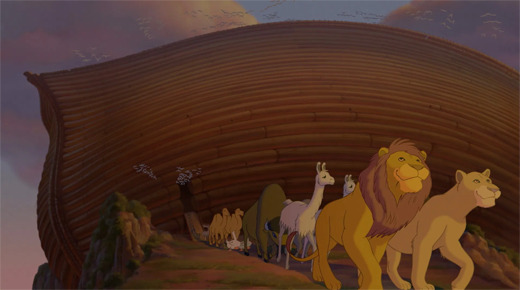
The eighth and final segment of Fantasia 2000 presents Igor Stravinsky’s The Firebird. Closing the show, it’s clear Disney felt this segment was the most perfect blend of music and animation. That it hit the highest heights, and would end the film with a definitive bang.
The segment depicts a benevolent forest spirit whose sylvan world is destroyed a volcanic eruption. The forest spirit is recognizable as warm, matronly, and and nurturing. She embodies the Mother Earth archetype, understood and sympathetic. But with her leafy, spectral appearance, eagle-like wings and angelic face, she’s an entity unto herself.

The way the short presents itself, it initially seems as though it’s a parable about pollution. The spirit is at the mercy of a temporarily unseen adversary, belching forth a cloud of smoke. Perhaps this was the original story at an early stage of development.
If this had been an environmental tale, it would be simple. It would be extremely one-dimensional and low stakes. Of course no one is going to root against a living forest as its felled by industrial machinery. Of course toxic waste and pollution are evil. What kind of moral for a story would that be?
Instead, it’s not a story about nature vs man. It’s a story of nature vs nature. Our hero is nature. Our villain is also nature. With all the beauty and life in the natural world, there are also powerful destructive forces.

The villain presents him self as an enormous hawk, composed of magma, belching forth a blast of fire. Our hero, in all her power, is dwarfed by the adversary. She cannot fight. She cannot hide. She can barely flee. She is at the mercy of a foe she had never considered.

What could have been a boilerplate story about conservation is now a deeply metaphoric fable. Where there is order, there is chaos pushing its way in. Where there is growth, there is loss. Where there is life, there is death.
A forest full of thriving life has been eradicated. A painstakingly curated ecosystem wiped out almost instantly. So much work, effort, love and beauty, all for naught. Everything is consumed by a torrent of molten rock, fire, and ash. It’s left the ground bare, gray, and empty. Things seem hopeless.

This isn’t a story about nature. This is a story using nature to tell a story. It’s a story about overcoming adversity. Through drive, determination, and tenacious endurance, the spirit overcomes. Things regrow. The forest is as verdant and lively as ever. That which does not kill, only makes stronger. After all, what is more nutrient rich and fertile than volcanic soil?
It’s a fable using nature as a visual representation of perseverance and hardships. Bad things will happen. Devastating things, even. But if the spirit is strong and willing, you can overcome. You can rebuild. You can start anew. Where there is life, there is death. But where there is life, there is also hope.

Visually it’s beautiful. Thematically, it’s powerful. Musically, it’s wonderful. It’s truly the best way to end the film.
Fantasia 2000 ends similar to how it began. Images again soar over the heads of the orchestra. Now, the classic stills from 1940 have been replaced with 2000′s original segments. Integrated into the Fantasia legacy, they now also belong to the ages. They are as every bit part of Fantasia’s family as their forbearers.

Fantasia 2000 had many things going against it. The odd release strategy targeting only specific screens was chief among them. It played in a very small number of theaters to a very limited audience. It wasn’t made for families in mind, but a far more discerning crowd. A brave decision, but haughtiness wouldn’t bring acknowledgment or acclaim.
Both Fantasias failed in similar ways, with slight differences in detail. Both were far too ambitious, artistic, and alienated the average moviegoer. Audiences expected certain things from Disney Animation, such as entertainment and mirth. Deeply artistic, experimental productions were not on the list.
While Fantasia has a level of acclaim today, most of it is nostalgia rather than honest appreciation. It’s largest section of champions aren’t Disney fans and families, but film scholars. The filmgoing public simply doesn’t care for classical music.

Fantasia 2000 may also have an opportunity to earn a retroactive appreciation. Maybe, but it will require every bit of piggybacking off the original’s reputation. Fantasia 2000 still stands in the shadows of the original movie. Its insistence on comedic frivolities, underdeveloped concepts, outdated CGI animation, and the forced inclusions of guest hosts make the film seem desperate. There are definite bright spots in the film, but they’re outnumbered. The film wanted to be hip and trendy and fashionable in its era, but it sacrificed longevity and honesty to achieve it. And it wasn’t even that hip, trendy or fashionable.
Fantasia was a failed experiment to make an ongoing, evolving film project, but Fantasia 2000 was not the only attempt to fulfill the idea. In the early 1990s, a film called “Musicana” was proposed as a Fantasia follow-up, but nothing came of it. At Disney parks, the Philharmagic show carries Fantasia’s legacy. Mickey Mouse, Donald Duck and other animated characters continue to bring classical music to life.

It’s an open secret that production was quietly started on a third Fantasia before Fantasia 2000′s release. This project would focus heavily on world music. But after the lackluster reception to Fantasia 2000, the project was abandoned before anything was officially announced. Several animated shorts from the early 2000s are survivors of the jettisoned project. Specifically, Destino (Mexico), The Little Matchgirl (Russia), Lorenzo (Argentina), and One by One (South Africa).

These four shorts appeared independently of the Fantasia brand, either attached to features or at festivals. Disney’s animators continue to make ambitious and thematic short animations set to music, clearly influenced by Fantasia, just not carrying the cursed name. The evidence dictates Fantasia is a better concept than an actual product.
Fantasia is an idea that’s been tried, tested, and unwanted by mass audiences. A film company, even one as big and influential as Disney, is beholden to the market. Film, music, and animation can carry thoughts, share ideas, convey feelings, and tell stories. But Fantasia 2000 just didn’t find receptive eyes and ears.
Beauty and the Beast
Fantasia
The Lion King
Snow White and the Seven Dwarfs
Cinderella
Alice in Wonderland
Sleeping Beauty
Mulan
The Little Mermaid
Aladdin
The Many Adventures of Winnie the Pooh
Pinocchio
The Jungle Book
Robin Hood
The Sword in the Stone
Bambi
The Hunchback of Notre Dame
The Great Mouse Detective
101 Dalmatians
The Three Caballeros
Lady and the Tramp
The Rescuers Down Under
The Fox and the Hound
Fantasia 2000
Peter Pan
Dumbo
Hercules
The Black Cauldron
Melody Time
Oliver & Company
Tarzan
The Rescuers
Pocahontas
Saludos Amigos
The Adventures of Ichabod and Mr. Toad
The Aristocats
Fun and Fancy Free
Make Mine Music
#Fantasia 2000#Disney#Walt Disney Animation Studios#walt disney#disney studios#Disney Canon#Film Criticism#film analysis#movie review
4 notes
·
View notes
Text
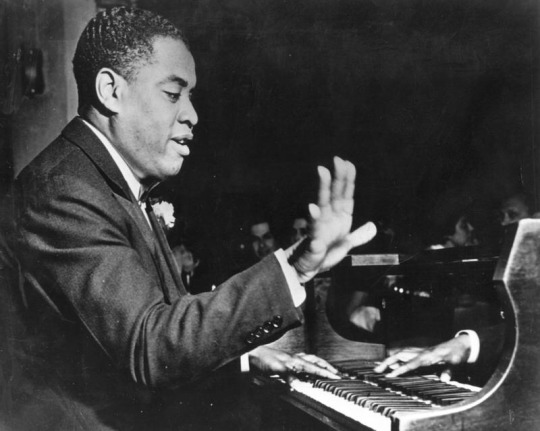
youtube
Happy BornDay Art Tatum...
Jazz Profiles from NPR — Art Tatum...
One of the greatest improvisers in jazz history, Art Tatum also set the standard for technical dexterity with his classic 1933 recording of "Tea for Two." Nearly blind, Tatum's artistic vision and ability made him an icon of jazz piano, a musician whose impact will be felt for generations to come.
Listen to pianists Hank Jones and Oscar Peterson, clarinetist Buddy DeFranco and vocalist Jon Hendricks and Tatum biographer James Lester talk about Art Tatum
While Tatum's skills were undeniable, his style continues to stir controversy on whether or not he was an "official" jazz musician. Some jazz critics dismissed his playing as so much ornate window-dressing and the pianist himself as a novelty instead of a serious jazz artist; others saw him as the new and improved second coming of stride legend Fats Waller, one of Tatum's idols.
What made Tatum's music even more astonishing was watching his extremely calm demeanor as his nimble figures raced up and down the ivories. According to a radio interview with "Voice of America" host Willis Conover, however, Tatum was never fully satisfied with his amazing deftness.
Born Arthur Tatum, Jr. on October 13, 1909 in Toledo, Ohio, the pianist had lost most of his sight by the age of four. He received some formal training on the piano at the Toledo School of Music, learning to read sheet music with the aid of glasses and then in Braille. But Tatum was primarily self-taught, cribbing from piano rolls, phonograph recordings, and radio broadcasts while learning what he could from musicians he encountered.
By 19, Tatum he was playing with vocalist Jon Hendricks at Toledo's Waiters & Bellman's Club, a popular local jazz club that hosted national acts as well. A few of those national acts -- Louis Armstrong, Duke Ellington, Count Basie and Andy Kirk among them -- took notice of the young house pianist, often stunned by his speed and dexterity...
In 1932, Tatum traveled to New York with vocalist Adelaide Hall (left). His reputation had arrived earlier and some of New York's finest jazz musicians were eagerly awaiting his arrival. The following year, Tatum cut his first sides, for the Brunswick label. The first song was aforementioned "Tea for Two," which became his signature tune.
Tatum's stay in New York was brief, and he returned to the Midwest, playing in Cleveland and Chicago for the mid-1930s. He made a triumphant return to New York in 1937, playing at several clubs and appearing on national radio shows.
The following year, Tatum toured England and he began appearing regularly in New York and Los Angeles in the late 1930s and early 1940s. Taking Nat "King" Cole's successful jazz trio as a model, Tatum founded his own influential trio with Slam Stewart (double bass) and Tiny Grimes (electric guitar) in 1943. Grimes left the following year, but Tatum continually returned to this format, playing with guitarist Everett Barksdale in particular.
Tatum was not only made a favorite among jazz musicians, but also European classical musicians like Conductor Leopold Stokowski, composer Sergei Rachmaninov and pianist Vladimir Horowitz. But as Tatum's virtuosity continued to awe his fellow musicians, many music critics vilified his playing as being overbearing.
Although Tatum was not considered a bebop jazz musician, he had a legion of bop followers like the alto saxophone icon Charlie Parker and pianist Bud Powell, and he became a mentor for pianists Billy Taylor and Oscar Peterson. His obsession with music didn't prevent him from indulging in his other favorite activities: sports and cards.
As bebop began to take control of jazz in the early 1950s, Tatum continued playing variations of the stride piano style, mostly at small clubs throughout the country. In in 1953, Tatum tracked a record 124 solos for noted producer Norman Granz and while the sessions were hasty, they yielded material for 13 albums.
Soon after, Granz assembled an all-star group of jazz musicians like vibraphonist Lionel Hampton, drummer Buddy Rich, saxophonist Ben Webster, trumpeter Harry "Sweets" Edison and clarinetist Buddy DeFranco to record with Tatum. During these sessions many musicians were just as amazed at the amount of beer Tatum drank as they were about the amount of musical virtuosity continued to stream out of Tatum's hands.
Although his excessive drinking didn't affect his playing, it did unfortunately affect his health. By 1952, Tatum began showing evidence of euremia, a toxic blood condition resulting from a severe kidney disease. On November 5, Tatum died at age 47, and although his career was relatively short, Tatum's brilliant playing still remains unparalleled and highly influential...
See also:
- Art Tatum: No Greater Art — Talkin’ Tatum with Hank Jones, Billy Taylor, Dick Hyman, Adam Makowicz
- 8 Ways Thelonious Monk was influenced by Art Tatum
- A history of jazz Jazz: Art Tatum stuns his contemporaries in New York
8 notes
·
View notes
Text
2020 Olympics Poland Roster
Archery
Sławomir Napłoszek (Warsaw)
Sylwia Zyzańska (Zwiec)
Athletics
Krzysztof Różnicki (Lebork)
Rafał Augustyn (Dębica)
Artur Brzozowski (Nisko)
Mateusz Borkowski (Starachowice)
Patryk Dobek (Kościerzyna)
Marcin Lewandowski (Szczecin)
Michał Rozmys (Lubsko)
Dawid Tomala (Tychy)
Konrad Bukowiecki (Szczytno)
Paweł Fajdek (Świebodzice)
Michał Haratyk (Cieszyn)
Marcin Krukowski (Warsaw)
Piotr Lisek (Duszniki)
Piotr Małachowski (Żuromin)
Wojciech Nowicki (Białystok)
Paweł Wojciechowski (Bydgoszcz)
Karol Zalewski (Reszel)
Damian Czykier (Białystok)
Kajetan Duszyński (Semianowice Śląskie)
Patryk Grzegorzewicz (Toruń)
Dariusz Kowaluk (Komarówka Podlaska)
Jakub Krzewina (Kruszwica)
Mateusz Rzeźniczak (Łódź)
Wiktor Suwara (Łódź)
Marcin Chabowski (Wejherowo)
Arkadiusz Gardzielewski (Tczew)
Adam Nowicki (Gdynia)
Łukasz Niedziałek (Siedlach)
Robert Sobera (Wrocław)
Konrad Bukowiecki (Szycztno)
Michał Haratyk (Cieszyn)
Bartłomiej Stój (Przędzel)
Cyprian Mrzygłód (Skaratki Pod Rogóźno)
Paweł Wiesiołek (Wyszków)
Aneta Konieczek (Zbaszyn)
Paulina Guzowska (Warsaw)
Marlena Gola (Białystok)
Iga Baumgart-Witan (Bydgoszcz)
Natalia Kaczmarek (Wrocław)
Alicja Konieczek (Zbąszyń)
Joanna Linkiewicz (Wrocław)
Klaudia Siciarz (Kraków)
Pia Skrzyszowska (Warsaw)
Ewa Swoboda (Żory)
Justyna Święty-Ersetic (Racibórz)
Katarzyna Zdziebło (Warsaw)
Klaudia Adamek (Nagłowice)
Małgorzata Hołub-Kowalik (Koszalin)
Kornelia Lesiewicz (Warsaw)
Maria Andrejczyk (Suwałki)
Joanna Fiodorow (Augustów)
Paulina Guba (Otwock)
Klaudia Kardasz (Białystok)
Malwina Kopron (Puławy)
Kamila Lićwinko (Białystok)
Anita Włodarczyk (Rawicz)
Joanna Jóźwik (Wałbrzych)
Angelika Sarna (Warsaw)
Anna Wielgosz (Nisko)
Martyna Galant (Witkowo)
Paulina Paluch (Warsaw)
Dominika Baćmaga (Warsaw)
Anna Kiełbasińska (Warsaw)
Aleksandra Lisowska (Osztyn)
Angelika Mach (Warsaw)
Karolina Jarzyńska-Nadolska (Oleśnica)
Adrianna Sułek (Warsaw)
Marika Popowicz-Drapała (Gniezno)
Basketball
Michael Hicks (Starogard Gdański)
Szymon Rduch (Gmina Siemyśl)
Paweł Pawłowski (Gdańsk)
Przemysław Zamojski (Elbląg)
Boxing
Damian Durkacz (Knurów)
Karolina Koszewska (Warsaw)
Elżbieta Wójcik (Karlino)
Sandra Drabik (Kielce)
Canoeing
Grzegorz Hedwig (Nowy Sącz)
Krzysztof Majerczak (Warsaw)
Tomasz Barniak (Węgorzewo)
Wiktor Głazunow (Gorzów)
Mateusz Kamiński (Olsztyn)
Aleksandra Stach (Warsaw)
Klaudia Zwolińska (Nowy Sącz)
Dorota Borowska (Warsaw)
Marta Walczykiewicz (Kalisz)
Karolina Naja (Tychy)
Anna Puławska (Mrągowo)
Katarzyna Kołodziejczyk (Kalisz)
Helena Wiśniewska (Bydgoszcz)
Justyna Iskrzycka (Bielsko-Biała)
Equestrian
Jan Kamiński (Warsaw)
Małgorzata Cybulska (Warsaw)
Joanna Pawlak (Warsaw)
Fencing
Aleksandra Jarecka (Kraków)
Magdalena Piekarska (Warsaw)
Martyna Jelińska (Torun)
Renata Knapik-Miazga (Tarnów)
Ewa Trzebińska (Katowice)
Golf
Adrian Meronk (Hamburg, Germany)
Gymnastics
Gabi Janik (Kraków)
Judo
Piotr Kuczera (Knurów)
Maciej Sarnacki (Olsztyn)
Agata Perenc (Rybnik)
Julia Kowalczyk (Rybnik)
Agata Ozdoba-Błach (Opole)
Beata Pacut (Warsaw)
Pentathlon
Łukasz Gutkowski (Warsaw)
Sebastian Stasiak (Starogard Gdański)
Anna Maliszewska (Zielona Góra)
Sailing
Piotr Myszka (Mrągowo)
Paweł Kołodziński (Gdańsk)
Łukasz Przybytek (Lipno)
Magdalena Kwaśna (Chojnice)
Kinga Łoboda (Gdynia)
Aleksandra Melzacka (Gdynia)
Zofia Noceti-Klepacka (Warsaw)
Jolanta Ogar (Brzesko)
Agnieszka Skrzypulec (Szczecin)
Shooting
Tomasz Bartnik (Warsaw)
Aneta Stankiewicz (Bydgoszcz)
Sandra Bernal (Warsaw)
Klaudia Breś (Bydgoszcz)
Aleksandra Jarmolińska (Warsaw)
Skateboarding
Amelia Brodka (Nowa Sarzyna)
Climbing
Aleksandra Mirosław (Lublin)
Swimming
Krzysztof Chmielewski (Warsaw)
Mateusz Chowaniec (Siemianowice Slaskie)
Jakub Majerski (Katowice)
Karol Ostrowski (Stargard)
Bartosz Piszczorowicz (Kalisz)
Kamil Siedradzki (Siemianowice Śląskie)
Konrad Czerniak (Puławy)
Paweł Juraszek (Dziewiątka)
Radosław Kawęcki (Głogów)
Jakub Kraska (Łódź)
Paweł Korzeniowski (Oświęcim)
Jan Kozakiewicz (Warsaw)
Jakub Skierka (Zielona Góra)
Kacper Stokowski (Warsaw)
Kacper Majchrzak (Poznań)
Jan Hołub (Wroclaw)
Paulina Peda (Katowice)
Kornelia Fiedkiewicz (Wroclaw)
Laura Bernat (Lublin)
Katarzyna Wasick (Kraków)
Table Tennis
Natalia Bajor (Brzeg)
Qian Li (Tarnobrzeg)
Natalia Patryka (Gdańsk)
Taekwondo
Patrycja Adamkiewicz (Jarocin)
Aleksandra Kowalczuk (Olsztyn)
Tennis
Hubert Hurkacz (Wrocław)
Łukasz Kubot (Lubin)
Kamil Majchrzak (Piotrków Trybunalski)
Iga Świątek (Raszyn)
Magda Linette (Poznań)
Alicja Rosolska (Warsaw)
Volleyball
Michał Bryl (Łask)
Grzegorz Fijałek (Andrychów)
Piotr Kantor (Sosnowiec)
Bartosz Łosiak (Jastrzębie-Zdrój)
Piotr Nowakowski (Żyrardów)
Łukasz Kaczmarek (Krotoszyn)
Bartosz Kurek (Wałbrzych)
Wilfredo León (Warsaw)
Fabian Drzyzga (Częstochowa)
Grzegorz Łomacz (Ostrołęka)
Michał Kubiak (Wałcz)
Aleksander Śliwka (Jawor)
Jakub Kochanowski (Giżycko)
Kamil Semeniuk (Kędzierzyn-Koźle)
Paweł Zatorski (Łódź)
Mateusz Bieniek (Blachownia)
Weightlifting
Bartłomiej Adamus (Skoroszyce)
Arkadiusz Michalski (Głogów)
Joanna Łochowska (Zielona Góra)
Wrestling
Kamil Rybicki (Warsaw)
Tadeusz Michalik (Warsaw)
Magomedmurad Gadzhiev (Biazogard)
Jowita Wrzesień (Warsaw)
Roksana Zasina (Łódź)
Agnieszka Wieszczek-Kordus (Wałbrzych)
Cycling
Maciej Bodnar (Oława)
Michał Kwiatkowski (Chełmża)
Rafał Majka (Zegartowice)
Patryk Rajkowski (Kórnik)
Mateusz Rudyk (Oława)
Krzysztof Maksel (Paczków)
Szymon Sajnok (Kartuzy)
Daniel Staniszewski (Ciechanów)
Bartłomiej Wawak (Bielsko-Biała)
Marta Lach (Głębowice)
Katarzyna Niewiadoma (Limanowa)
Anna Plichta (Wadowice)
Marlena Karwacka (Sławno)
Urszula Łoś (Pruszków)
Daria Pikulik (Darłowo)
Wiktoria Pikulik (Darłowo)
Maja Włoszczowska (Warsaw)
Rowing
Mateusz Biskup (Gdańsk)
Mirosław Ziętarski (Ciechocin)
Jerzy Kowalski (Toruń)
Artur Mikołajczewski (Inowrocław)
Fabian Barański (Włocławek)
Wiktor Chabel (Sandomierz)
Dominik Czaja (Kraków)
Szymon Pośnik (Warsaw)
Marcin Brzeziński (Warsaw)
Mikołaj Burda (Toruń)
Michał Szpakowski (Toruń)
Mateusz Wilangowski (Mokre)
Agnieszka Kobus-Zawojska (Warsaw)
Maria Sajdak (Kraków)
Marta Wieliczko (Gdańsk)
Katarzyna Zillmann (Toruń)
Monika Ciaciuch-Chabel (Ślesin)
Joanna Dittmann (Bydgozycz)
Olga Michałkiewicz (Szczecinek)
Maria Wierzbowska (Kraków)
0 notes
Text
🌱 NIEDZIELA 4 SIERPNIA 2019

🕑 10.00-18.00
Miejski Serwis Rowerowy
📍Ząbkowska przy ul. Targowej
Mobilny serwis rowerowy, w którym serwisanci bezpłatnie dokonają przeglądu i regulacji rowerów, a także drobnych napraw. Przyjdź, sprawdź stan łańcucha, hamulców i przerzutek, załątaj dętkę albo napnij szprychy.

🕑 11.00-12.30
Bezpłatne warsztaty "Żyć oszczędnie, zdrowo i ekologicznie"
📍ul. Ząbkowska
Żyć oszczędnie, zdrowo i bardziej ekologicznie jednocześnie? To możliwe dzięki stylowi życia "zero waste" (z angielskiego "bez śmieci"). Bezpłatne warsztaty dla rodzin realizowane w ramach projektu do budżetu partycypacyjnego pt. Praga bez śmieci - kampania edukacyjna na rzecz bezodpadowej Pragi na Festiwalu OTWARTA ZĄBKOWSKA.
Wszyscy jesteśmy "producentami" odpadów, a skala ich powstawania z roku na rok rośnie. Polacy wytwarzają ich coraz więcej: na głowę to już ponad 320 kg rocznie!
Dlaczego odpady są problematyczne? Jak możemy żyć jednocześnie bardziej oszczędnie, zdrowiej i bardziej ekologiczne? Dlaczego plastik jest tak groźny dla naszego zdrowia i dla środowiska?
Styl życia „zero waste” przynosi odpowiedzi na te pytania i udowadnia on, że każdy z nas może zostać „światozmieniaczem". Wystarczy, że zmienimy sposób myślenia i niektóre z naszych codziennych nawyków. W zamian zyskamy korzyści finansowe, zdrowotne oraz ogromną satysfakcję ze wspierania lokalnej gospodarki i dobrego wpływu na społeczeństwo.
Styl „zero waste” jest coraz bardziej popularny w Polsce i na świecie. Dołącz do nas, aby dowiedzieć się, jakie proste i niewymagające wysiłku zmiany możesz wdrożyć już dziś u siebie w domu: od naturalnych kosmetyków po zdrową żywność dla całej rodziny, od zastąpienia plastiku po domowy kompostownik… Wystarczy tylko zacząć! :-)
Jak i gdzie zacząć? Przedstawimy niezbędnik „zero waste”, czyli jak zamienić przedmioty jednorazowe na te wielokrotnego użytku.
Wasze pierwsze kroki. Porozmawiamy o wyzwaniach i sukcesach na drodze do zdrowszego, bardziej ekologicznego i prostszego życia. Miło jest dzielić się doświadczeniami! Siła jest w nas!
Zajęcia praktyczne: przygotujemy własne wielorazowe torby na zakupy przy wykorzystaniu T-shirtów. Przynieś nam swój T-shirt, wspólnie zamienimy go w torbę na zakupy!
Liczba miejsc ograniczona.
Więcej informacji i zapisy na warsztaty pod adresem:
[email protected]
Kampania “Praga bez śmieci” jest finansowana przez Budżet Obywatelski w Dzielnicy Praga-Północ
Autorką projektu jest Pani Karolina Siatkowska-Luśtyk
Kampania jest zrealizowana przez Little Greenfinity

🕑 12.00-18.00
Otwarte Pracownie Artystyczne
📍Ząbkowska i okolice
W weekend 3-4 sierpnia lokalne praskie pracownie artystyczne otworzą swoje drzwi dla odwiedzających.
Stwórzcie swój własny szlak lub skorzystajcie ze specjalnie przygotowanych przez Praską Ferajnę spacerów.
Partnerzy wydarzenia: Grupa twórcza Stan Rzeczywisty i Praska Ferajna
🖌 Pracownia Twórcza - Anna Szuflicka (design) i Adam Machnio (malarstwo) , ul. Brzeska 14 lok 17/19 - otwarte 3 i 4 sierpnia w godz. 12.00 - 18.00
🖌 PRACOWNIA 23 - Edyta Dzierż (malarstwo), ul. Floriańska 12 lok. 23 (domofon 23) 3 klatka w podwórku - otwarte 4 sierpnia od 15.00 - 18.00
🖌 Pracownia malarska na Łomżyńskiej -Joanna Świerczyńska (malarstwo) i Dorota Gąsiorska - (linoryt), ul. Łomżyńska 30 lok. 5 - otwarte 3 sierpnia od 15.00 -18.00
🖌 Pracownia artystyczna - Magdalena Hajnosz (malarstwo) oraz Zofia i Jan Kubiccy (rzeźba), ul. Wołomińska 11 - otwarte 3 sierpnia od 15.00 -18.00
🖌 K105K Kwiaciarnia Eksperymentalna - ul. Brzeska 9, otwarte 3 i 4 sierpnia w godz. 12.00 - 18.00
🖌 Pracownia Gościnna - Natalia Żychska (malarstwo), ul. Brzeska 9, otwarte 3 i 4 sierpnia w godz. 12.00 - 18.00
🖌 Ceramiczny kramik BaKu - Barbara Kuczyńska (ceramika), ul. Ząbkowska 39A, otwarte 3 sierpnia od 15.00 - 18.00
Spacery po pracowniach z Praską Ferajną:
👉 Sobota, 3 sierpnia, godz 15:00
Start ul. Łomżyńska 30 (róg ul. Otwockiej)
Pracownie artystów Szmulowizny i Pragi
👉 Niedziela, 4 sierpnia, godz 15:00
Start ul. Floriańska 14 (róg al. Solidarności)
Pracownie artystów Nowej Pragi

🕑 12.00-18.00
Otwarta Strefa Twórców. Targi Sztuki i Rzemiosła Artystycznego
📍ul. Ząbkowska
Stoiska w przestrzeni ulicy Ząbkowskiej stworzone przez artystów i rzemieślników. Rzadka okazja do zakupienia unikalnych artystycznych przedmiotów. Ciekawe wytwory oferowane przez twórców rzemiosła artystycznego i artystów. Stoiska z przedmiotami użytkowymi o wysokim walorze artystycznym: biżuteria, tekstylia, moda. Prace młodych artystów: malarstwo, grafika tradycyjna (linoryt, litografia, akwaforta, akwatinta i inne), ceramika.

🕑 14.00-18.00
Płyty Gramofonowe w ogródku | Sienicki
📍Ząbkowska Grolschownia
Przez cały czas trwania Festiwalu OTWARTA ZĄBKOWSKA, w każdą niedzielę, w ogródku u sąsiadów z Ząbkowska Grolschownia będziecie mieli okazję posłuchać DJ-skich setów zagranych z winyli przez zaproszonych przez nas gości. Startujemy zawsze o 14.00 i kończymy o 18.00. 14-18 to również niedzielne godziny otwarcia sklepu w wakacje.
Zapraszamy na digging, zimne drinki i odpoczynek przy dobrej muzyce granej z winyli.

🕑 15.00-18.00
Pracownie artystów Nowej Pragi
📍Start ul. Floriańska 14 (róg al. Solidarności)
Na Nowej Pradze jest mnóstwo street-artu i galerii, a ulica Stalowa jest ich zagłębiem. My jednak skoncentrujemy się na pracowniach artystów, którzy tu tworzą obrazy, ceramikę, sztukę użytkową, rzeźby rzeczywiste i wirtualne. Odwiedzimy i tych światowej sławy i tych mniej znanych. Można będzie nie tylko zobaczyć ich prace, ale także porozmawiać z samymi twórcami. Zaczniemy jednak od Starej Pragi, a zakończymy na osiedlu Praga II.
Spacer odbywa się w ramach projektu OTWARTA ZĄBKOWSKA i wydarzenia Otwarte pracownie artystyczne / Otwarta Ząbkowska.
NIEDZIELA, 4 sierpnia godz. 15:00
Spotkanie: ul. Floriańska 14 (róg al. Solidarności)
Przewodnik: Jarek Spacerolog Praski
Spacer potrwa ok. 2,5-3 godziny
Harmonogram wszystkich naszych spacerów na www.PraskaFerajna.WAW.PL
Spacery nie są biletowane, ale na zakończenie bardzo mile widziany suty pourboire ;-)

🕑 14.00-15.00
„Kartki z Powstania” - inscenizacja historyczna
📍ul. Ząbkowska
W ramach obchodów 75 rocznicy Powstania Warszawskiego na Pradze, na ul. Ząbkowskiej odbędą się trzy powstańcze epizody z udziałem grup rekonstrukcyjnych i pojazdów historycznych.
1. Początek powstania
2. Starówka – przebicie do Śródmieścia i ewakuacja
3. Berlingowcy na Pradze

🕑 18.00
Galeria Ząbkowska 11 - Wernisaż wystawy Magdaleny Hajnosz
📍Galeria Ząbkowska 11
"Interesuje mnie światło, kolor i przestrzeń. Moje prace nie są dosłowne to raczej sugestie, staram się stymulować wyobraźnię widza, który patrząc na obrazy, widzi coś niepowtarzalnego. Daję mu ścieżkę po której ma pójść sam, gdzie sam może zbudować swój świat który mu udostępniam kolorami.
Zachęcam widza aby wszedł do środka mojego obrazu dając mu jako nić przewodnią kolory i kompozycje które budują nastrój niezbędny do snucia własnych historii. Zapraszam chętnych aby puścić wodze fantazji i nie przywiązując się do pozorów rzeczywistości wejść w mój świat.
Po fascynującym lecz męczącym zgiełku miasta wzrok z rozkoszą gubi się w dalekich horyzontach.
Dla mnie zaprzysięgłego mieszczucha to zupełnie inny świat w którym wypoczywam. Mam niemal namacalne wrażenie spokoju i oddalenia od spraw codziennych, pomimo że wiem iż pomiędzy trawami toczy się walka na życie i śmierć mniejszych i większych stworzeń, lecz mój wzrok ogarnia daleki horyzont ze spokojem.
Maluję różne wątki tematyczne: wielką inspiracją jest dla mnie muzyka i taniec, maluję także pejzaże miasta bez którego nie mogę żyć, a także naturę i krajobrazy. Mieszkałam przez dekadę w Belgii i widoki ardeńskie były inspiracją do wielu obrazów.”
Magdalena Hajnosz
Urodzona w Warszawie, uzyskała stopień magistra sztuki Akademii Sztuk Pięknych w Warszawie.
Prace Magdaleny Hajnosz prezentowane były na wielu wystawach indywidualnych i zbiorowych w Polsce i w Belgii.
Laureatka nagród w konkursach plastycznych i fotograficznych.
Nagrody w konkursach na kartony tkackie w Belgii – 1990 druga nagroda i ‘93 i pierwsza, w konkursach na karton tkacki „Domaine de la Lice” (Bruksela); 1990 i 93 wyróżnienia w konkursach na karton tkacki „Prijs der Stadt Oudenaarde” , 2008, 2009, 2011 nagrody w konkursach fotograficznych w Polsce
2010 publikacja autorskiej książki „Warszawa z głową do góry” - przewodnik fotograficzny; wydana przez Bibliotekę Stolicy.
www.magdalena-hajnosz.art.pl
https://www.facebook.com/PracowniaOtwArtaFolwarczna5/
https://www.instagram.com/magdalenahajnosz/

🕑 19.00-21.00
Lato Konesera: Klasyczne niedziele
📍Centrum Praskie Koneser, Plac Konesera
Lato Konesera to doskonała okazja, by odwiedzić to klimatyczne miejsce na Pradze i w dobrym towarzystwie spędzić czas. Tym bardziej, że każdy powinien znaleźć coś dla siebie, od singli, przez rodziny z dziećmi, po seniorów. Atrakcje zaś zaplanowano na całe wakacje i każdego dnia realizowane są inne projekty.
🎶 4 sierpnia
„Z Nowego Jorku do Moskwy i z powrotem”
Ania Karpowicz (flet), Marek Bracha (fortepian)
W PROGRAMIE:
Aaron Copland - "Duo" na flet i fortepian
Tadeusz Zygfryd Kassern - "Sonatina nowojorska" (1948)
Mieczysław Weinberg - "5 Pieces" na flet i fortepian

🕑 20.00-22.00
Orkiestra z Chmielnej - koncert
📍Ząbkowska Grolschownia
W naszej Ząbkowskiej Grolschowni na warszawskiej Pradze zagra Orkiestra z Chmielnej w składzie :
Janek Stokowski - akordeon i wokal- warszawski bard, od lat śpiewa i bawi publiczność, występuje z Orkiestra z Chmielnej od lat !
Zbyszek Tokarski- skrzypce- doświadczenie muzyczne zdobył w Mazowszu , gra z Orkiestra
Andrzej Boguracki -gitara i wokal - grał w jednym z pierwszych składów z Orkiestry z Chmielnej
Trio bardów Warszawy zagra koncert folkowy :
w repertuarze warszawskie szlagiery z przed lat takie jak : Panna Andzia ma wychodne, Warszawo da się lubić , Czerwony autobus, U cioci na imieninach, Czy tutaj mieszka Panna Agnieszka, Umówiłem się z nią na dziewiąta, Zimny drań, Chodź na Pragę, Baby ach te baby, Na prawo most , Jak przygoda to tylko w Warszawie, Hanko, i wiele innych.
gramy od 20.00 !
zapraszamy do tańca i wspólnego śpiewania - zapewniamy niecodzienną atmosferę i dobra zabawę!

0 notes
Text
May 14 in Music History
1652 Birth of composer Johann Philipp Fortsch.
1574 Birth of Italian tenor Francesco Rasi in Arezzo.
1707 Birth of composer Antonio Teixeira.
1723 FP of G. F. Handel´s opera Flavio at the King's Theater in London.
1748 FP of Gluck's opera Semiramide Riconosciuta for the reopening of the Burgtheater in Vienna.
1749 FP of Galuppi's "L'Arcadia in Brenta" Venice.
1749 Opening of the Burgtheater, Vienna.
1763 FP of Gluck's "Il trionfo di Clelia" Vienna.
1788 FP of Dalayrac's "Sargines" Paris.
1791 Death of German singer and composer Francesca Lebrun in Berlin.
1799 FP of G. Ferrari's "I due Svizzeri" London.
1805 Birth of Danish organist and composer Johann Peter Emilius Hartmann.
1816 Birth of composer Gualtiero Sanelli.
1832 FP of the Hebrides Overture by Mendelssohn, conducted by the composer from the manuscript at Covent Garden, London.
1842 Birth of composer Alphons Czibulka.
1845 FP of Balfe's "The Enchantress" London.
1847 Death of composer and pianist Fanny Mendelssohn Hensel.
1853 Birth of Italian tenor Francesco Marconi.
1855 FP of Halévy's "Jaguarita l'indienne" Paris.
1863 Birth of French tenor Pierre Cornubert.
1864 Birth of American composer and singer Eleanor Everest Freer.
1872 Birth of composer John Stepan Zamecnik.
1874 Birth of Italian tenor Giuseppe Armanini in Milan.
1883 Birth of #composer Juan Manen
1885 Birth of German conductor Otto Klemperer in Breslau.
1889 FP of Massenet's "Esclarmonde" Paris.
1891 Birth of composer Egon Kornauth.
1892 Birth of Russian composer Arthur Vincent Lourie´, in Paris.
1892 Birth of composer Felix Petyrek.
1893 Birth of composer Ivan Alexandrovich Vishnegradsky.
1895 Birth of composer Renato Lunelli.
1898 Birth of composer Bonifacio Gil Garcia
1900 Birth of Dutch composer Leo Smit in Amsterdam.
1902 Birth of #tenor Antonio Salvarezza.
1908 Birth of German bass Helmut Eyle in Halberstadt.
1911 Birth of composer Hans Vogt.
1914 FP of Richard Strauss' ballet Josephslegende in Paris.
1917 Birth of American composer Lou Harrison in Portland, OR.
1917 Birth of American choral conductor Norman Luboff in Chicago.
1917 Birth of Austrian baritone Hans Braun in Vienna.
1919 Birth of German tenor Martin Vantin in Nurnberg.
1919 FP of Claude Debussy's Saxophone Rhapsody orchestrated by Roger-Ducasse. Société Nationale de Musique, conducted by André Caplet at the Salle Gaveau in Paris.
1924 Birth of Portuguese composer Joly Braga-Santos in Lisbon.
1923 FP of Gustav Holst's opera The Perfect Fool at Covent Garden, London.
1925 Birth of American soprano Patrice Munsel in Spokane WA.
1925 Birth of composer Tristram Ogilvie Cary.
1926 Birth of composer Cestmir Gregor.
1930 Birth of American soprano Margaret Hoswell.
1931 Birth of American composer Alvin Lucier in Nashua, NH.
1931 Birth of German pianist Aloys Kontarsky, in Westphalia.
1936 Birth of American mezzo-soprano Joann Grillo in Brooklyn, NY.
1937 Birth of composer Peter Frederic Williams.
1940 Birth of Austrian bass-baritone Peter Wimberger in Vienna.
1941 FP of John Cage's Third Construction for four percussionists in San Francisco.
1942 Birth of American composer Gerald Shapiro in Philadelphia, PA.
1942 FP of Aaron Copland's Lincoln Portrait, narrated by William Adams and Cincinnati Symphony Orchestra conducted by Andre Kostelanitz.
1943 Birth of American composer and conductor Tania León in Havana, Cuba.
1948 Birth of Welsh composer Albert Alan Owen in Bangor, Wales.
1947 Birth of English composer and singer Peter Skellern.
1948 Birth of American soprano Carmen Balthrop in Washington, DC.
1949 Birth of American pianist Alan Marks in Chicago.
1950 Birth of French pianist Maria de La Pau.
1951 Birth of Welsh soprano Helen Field in Anyn, North Wales.
1957 Birth of Italian soprano Daniela Dessi in Genoa.
1957 FP of Malipiero's "Il Figliuol prodigo" 1st stage perf. and his "Venere prigioniera" Florence.
1959 FP of Glanville-Hicks' "The Glittering Gate" New York (1959).
1965 Death of tenor Franz Gollnitz.
1965 American debut of cellist Jacqueline DuPre. Plays Elgar concerto in Carnegie Hall, NYC.
1966 FP of Alberto Ginastera's Concerto per Corde. Philadelphia Orchestra, Eugene Ormandy conducting.
1974 Final London performance by Leopold Stokowski at age 92 conducting premiere of Otto Klemperer's Merry Waltz by New Philharmonia Orchestra.
1978 Death of Ukranian bass Alexander Kipnis.
1986 FP of Einojuhani Rautavaara's Symphony No. 5. Finnish Radio Symphony, Paavo Berglund conducting in Helsinki.
1987 FP of Alvin Singleton's Shadows for orchestra. Atlanta Symphony, Robert Shaw conducting.
1992 FP of James MacMillan's Sinfonietta. London Sinfonietta, Martyn Brabbins conducting at Queen Elizabeth Hall in London
1993 FP of Philip Glass' opera Orphée. American Repertory Theater in Cambridge, MA.
2005 FP of English-Canadian composer Robert Farnon's Third Symphony.
1 note
·
View note
Photo

Patagonia Time lapse by Adam Colton & Adam Stokowski
24 notes
·
View notes
Photo

shaiapouf.wma
Listen on 8tracks or Playmoss
a mix to cope with the tragedy and melancholy of being Pouf
13 Tracks // Classical, Pop-Rock, Vaporwave
Tracklist:
Prince Charming / Adam and the Ants // Tubba Blubba’s Castle / Paper Mario OST // Saint-Saens: Danse Macabre / Leopold Stokowski & National Philharmonic Orchestra // Love Is Like Oxygen / Sweet // 2 - リサフランク420 現代のコンピュー / Macintosh Plus // What’s Up / Four Non-Blondes // In the Palace~ Lamentoso (キメラアント編) / Hunter x Hunter OST // Dedication / New Dreams Ltd. // Contemptuous Sniff / Pentaphobe // Violoncello’s Lament / Fullmetal Alchemist: Brotherhood OST // R E D E Y E / DUSK.FM // Sally’s Song / The Nightmare Before Christmas // ライトと熱の夜 / Costavision LO-FI
Notes: I woke up at 4am this morning and needed to compile a Pouf playlist. Why Pouf.....?
#hxh#hunter x hunter#shaiapouf#playlists#beamie's mixes#i also spent 4 hours on the cover art#why pouf
33 notes
·
View notes
Video
Nueva Noticia en Video en: http://noticias-video.com/patagonia-time-lapse-video/
Patagonia Time Lapse Video
If you ever need any time-lapsing done or a time machine built give me a shout – [email protected]
Adam Stokowski and I spent 2 weeks in Patagonia Country pursuing our new passion for time lapse video and rhino hunting. We visited Torre Del Paine Park, Chile. Glacier Park, Argentina & Fitz Roy, Argentina. Plus all the beauty in between. Many barbed wire fences were climbed…. this is what we captured. More trips to come…..
To read a full account of our journey and see some photos CLICK HERE, http://www.loadedboards.com/loadednews/index.php?post/2011/03/15/Timelapses-in-Patagonia
Motion was done in Final Cut Pro (getting a stage zero dolly soon, STOKED)
Canon 7D, Canon 5D,
Canon L series 50mm / L- series 24-70mm
B+W ND 1.8 and B+W Circular Polarize
Likes: 2112
Viewed: 241018
VER VIDEO EN VIMEO
- #Argentina
0 notes
Text
Longboarder Labs and Cal Streets brings you Dancing on a Board
Longboarder Labs and Cal Streets brings you Dancing on a Board
Aoy, this is Peter Markgraf, professional longboarder from Leipzig, Germany. My favorite discipline of longboarding is dancing. The great thing about dancing is the unbelievable possibility and multifaceted aspect about it. Dancing for me is vivid anarchy because there are no limits concerning tricks, and furthermore there are no rules, no limitations, which I truly love! Besides that, you are…
View On WordPress
#Adam Colton#Adam Stokowski#Bustin#Dancing#Ko Hyokoo#landyachtz#Leipzig#Loaded#Lotfi Lamaali#Peter Markgraf#Rayne
0 notes
Text
Fantasia at 34
A review by Adam D. Jaspering
By 1940, Disney proved he was as large a titan in the world of feature films as he was in animated shorts. But as the saying goes, a man's reach should exceed his grasp. His third feature, Fantasia, would be an audacious experiment.
Disney had been synchronizing animated cartoons to classical music since 1928. His trademarked Silly Symphony shorts earned him seven Academy Awards. They were a foundational element of the Disney empire, but they were outmoded by 1939. Audiences were preferring plot-driven shorts.
Coincidentally, another Disney creation was also in decline in this era. It’s hard to fathom, but Mickey Mouse’s popularity with audiences peaked in 1935. By 1939, he was eclipsed by both Donald Duck and Goofy. More frequently, Mickey appeared alongside the two than appearing in his own independent shorts.
Disney had plans to bring both musical shorts and Mickey Mouse back into the limelight. Disney employed the assistance of The Philadelphia Orchestra and conductor Leopold Stokowsky. The Sorcerer's Apprentice was completed in 1938, pairing Mickey Mouse with the music of Paul Dukas in a nine-minute cinematic epic.
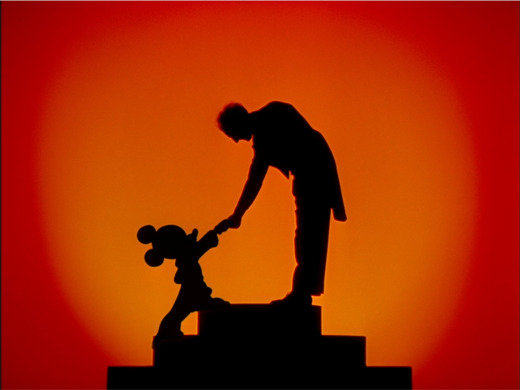
However, Walt Disney’s brother Roy, accountant for the company, crunched the numbers. The $125,000 budget made the short a logistical nightmare. To make a profit, the short needed to be released as a feature film. And to be a feature film, it needed to be feature length.
The Concert Feature, as it was initially called, grew in size and scale. The budget grew to $2.8 million. The crew ballooned to over one thousand artists and animators. After much effort and many headaches, Fantasia was finally released in November, 1940.
The film starts with a heavily stylized depiction of the orchestra and their instruments. The background is blue and vibrant, but every musician is ensconced in shadow. Lights from the music stands illuminate a negligible part or their personage. We can see the musicians, but only just.

From the onset, the film accomplishes two goals: First, it wants you to understand you are seeing live-action people. Mickey Mouse is on all the posters. Disney’s name is attached to the film. But these are real, non-animated people. Quite possibly the first live-action people filmed by Walt Disney since his Alice shorts.
Second, Fantasia wants you to realize you are seeing real people, but they are not the focus. The attention is not on them, but their instruments. This is a film not about people, but sound and music.
This is furthered as the sounds of Bach’s Toccata and Fugue in D Minor begins. The silhouettes of the musicians are projected onto the backdrop, scaled larger than their sources. The musicians become literal giants. The shadows create a form of puppetry, becoming indistinguishable from animation. Fantasy and reality, sound and imagery have become intertwined. It’s difficult to determine when the cameras stop rolling, and the ink and paints take over.

We are informed from the outset that Fantasia’s visuals are not those of trained musicians or scholars. These images are the thoughts and feelings of animators and artists. We are privy to new interpretations of classic works (well, new to 1940), beginning with Toccata and Fugue.
Defined as “Absolute Music,” Toccata and Fugue is an instantly recognizable piece of classical music. It is the go-to stock music whenever a movie, TV show or cartoon wants to quickly and unmistakably associate a scene with a sense of foreboding doom. But Fantasia undoes this eternally mired association; the booming bass offers no semblance of the intimidating or macabre.
Emcee Deems Taylor warns outright we’ll be experiencing non-representative form and abstract imagery. If the impressionist movement coexisted with film, it would probably resemble something like this. In a way, it’s almost a warning for impatient and fickle audiences. Doubly so, as it leads the procession of animated shorts. It’s a fair warning: This is experimental film. Your mileage may vary.

The abstraction gives way to the first representative piece. Tchaikovsky’s Nutcracker Suite; perhaps the most widely known ballet in modern society. We get a great demonstration about the longevity and shifting legacy of classical works as Taylor informs us “nobody performs it nowadays.” Art does not belong to an era, it belongs to the ages. I’m 34, and I’ve never known a Christmas where The Nutcracker wasn’t being performed somewhere in the city.
The Nutcracker Suite depicts the various flora and fauna of an enchanted forest, all engaged in a unique and stylized dance suited to their physique. What’s more, each movement is indicative to a nation and culture. We see Russian flowers, Arabian fish, French blossoms, and Chinese mushrooms (questionably stylized Chinese mushrooms. Thank you, 1940s).
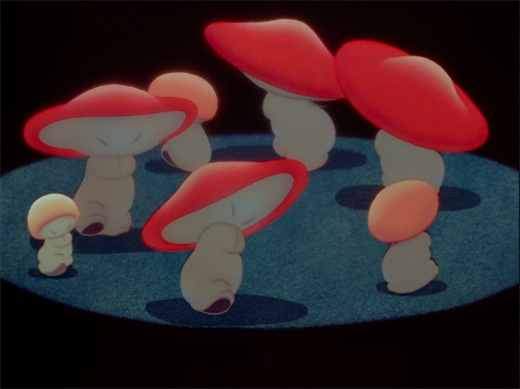
As problematic as the mushrooms are, I’m more perplexed by the Arabian fish. Obviously the sequence is an allusion to the eroticized stereotype of middle eastern women, particularly the Dance of Seven Veils and other subsequent belly dance numbers.
It’s a very g-rated version of the burlesque staple, but one has to wonder why it exists at all. At some point in the late 1930s/early 1940s, someone designed a fish to look and act like a belly dancer. Those eyes exist only for the purpose of portraying a sense of eroticism. Not to kinkshame somebody on Tumblr, but it’s very clear somebody on Disney’s staff was working through some things.
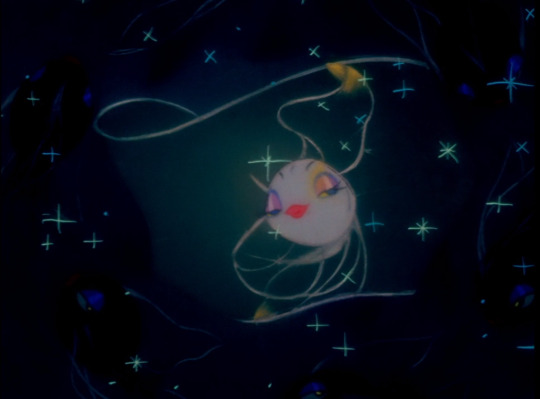
Each of these dances feature plants and animals evocative in style and movement of their corresponding dance’s nationality. This implies the animators were indeed versed on the background of Tchaikovsky’s Nutcracker Suite and his original intent. This breaks the promise from the start of the film: interpretations of artists, not of scholars.
It’s not an invalidating breach, and not total (surely Tchaikovsky never intended Clara and the prince to meet an amorous fish). But if Fantasia deliberately specified itself to not utilize scholarly interpretations. They waffled on this promise, and it should be noted.
Dukas’s The Sorcerer’s Apprentice is an interesting specimen. Not only has Mickey Mouse’s cautionary tale of a proper work ethic completely eclipsed its musical source in popular culture, but the short has eclipsed the entirety of Fantasia.
When one hears the word “Fantasia,” one’s mind immediately leaps to Mickey Mouse in a bathrobe. They think of the blue hat, festooned with stars. They think of an army of brooms, brought to life, obediently and endlessly carrying buckets of water. They think of the bassoons secondarily. Most are unaware the music existed before the movie.

That said, there is no better representation of Fantasia’s central tenet: a marriage of animation as an artistic medium and classical music as an eternal font of inspiration. In The Sorcerer’s Apprentice, not a word of dialogue is spoken and not a single intertitle is used. An idea is formed, expressed and delivered by the movement onscreen, buoyed by the themes and mood of the orchestral score. What results is a tale beloved for generations.
Stravinsky’s The Rite of Spring offers a brief history of prehistoric life. We see the cosmos create planet Earth. Tectonic plates shift and form land. Life is formed, evolving from single celled organisms, progressing up the evolutionary ladder. But this truncated history of eons and eons comprises only half the segment. The remainder is a grandiose depiction of life in the nadir of the Mesozoic Era. Dinosaurs in all their titanic glory.

Every few years, an animation company attempts to create a dinosaur-centered film. Either through lack of confidence or executive meddling, these dinosaurs aren’t allowed to simply be dinosaurs. We don’t see the glory of the creatures or the power struggle between herbivore and carnivore. Instead, these dinosaurs speak. They learn lessons and have character arcs. They’re often used as a parable of teamwork and community, or an allegorical tale of standing up to one’s oppressors.
Disney themselves fell into that trap in the year 2000, but we’ll address that soon enough. Dinosaurs are mesmerizing in their own right, as the animals they were. They require no personification. They need no story and no character. A musical short may be the closest we’ll ever get to such a film. For now, we can still enjoy the sight of a tyrannosaur fighting a stegosaurus to the death.

An interesting element of Fantasia, a remnant of a bygone era, is the intermission. When Taylor announced the film would break for a 15 minute intermission, I was concerned as the orchestra began slowly shuffling out of the amphitheater. Was the movie really going to stop? Fantasia is already fighting an uphill battle, trying to keep audiences with temperamental patience captivated. Stopping all inertia for fifteen minutes is suicidal.
Many films from the first half of film history, especially those longer than three hours, survive in their current forms with an intermission built in. Their home release is presented exactly as their theatrical release. The score’s overture plays over a meticulously designed title card, encouraging theater-goers to stretch their legs and visit the lobby. These intermissions have been preserved for posterity, but are wholly inconsequential with fast forward buttons and chapter select options.
I was concerned such would be the case for Fantasia, which barely crests the two-hour mark. It’s the longest of all Disney’s animated features, but surely that record is not because of a deliberate 15-minute time out? If persnickety audience of the 1940s needed a break, what of children in the digital age? They would minimize the window and never return.
Fantasia’s title card is present, but immediately returns back to the film, all for the better. It’s a pointless detour maintained for an illusion of legacy and integrity. Fantasia’s musical numbers are all well and good in their own right, but the live-action segments with the orchestra is full of questionable moments like these.
For example, at one point, a percussionist interrupts Deems Taylor by knocking over his bells. There’s no build up to this, no explanation, and no commentary. It happens, and is promptly forgotten. If it’s a joke, it makes no sense. If it’s a mistake, why was it left in?

Perhaps Disney had no idea how to carry these live segments. He was afraid to let the segments speak for themselves, feeling obligated to inject them with more than a curated introduction. He needed to pepper in little moments that would either change the dynamic or mandate attention.
These moments rob the gravitas delivered by the orchestra, interrupt the flow of the picture, and make the audience wait impatiently for the next segment. Disney Studios would experiment with live-action film over the next decade, but these missteps display exactly why Disney Studios was not ready for a fully live-action film until the 1950s.
Beethoven’s Pastoral Symphony is not the strangest segment of the film, but it becomes more surreal the more it’s examined. Early on, after a brief dance with satyrs, unicorns, and pegasi, we’re greeted with a number of topless, bathing centaurettes. One wouldn’t think Disney would brazenly depict frontal nudity, but there we are. Fully nude cherubs further the dissonance.

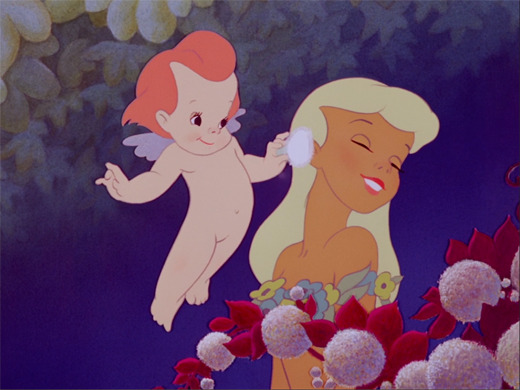
Greek and Roman mythology contains stories of heroes, legends, monsters, and adventure. It’s also rife with depictions of incest, rape, violence, and general malfeasance. Adapting any tale concerning the Olympians requires great skill, lest it be so thematically vulgar, it’s outright rejected by modern sensibilities. Even moreso when the tale is to be presented in a G-rated setting. As obvious a statement this may seem, it’s odd for Fantasia to have an entire segment dedicated to the Roman deity Bacchus and his trademark love of wine.

To say the wine flows is an understatement. A golden chalice overflows with some of the most tantalizing violet liquid ever depicted on film.I don’t even like wine, but I would take up a glass if it was offered.
Bacchus merrily sways back and forth in a drunken stupor for his entire appearance. Caught in a mixture of revelry and lightheadedness, the inebriated god is the central figure of a literal bacchanal. Fantasia was released the same year as Pinocchio, which depicted drunkards in such a negative light, they were turned into donkeys. Bacchus rides a unicorn-donkey who enjoys the taste of wine as much as his master. Behold: The duality of Disney.

Ponchielli’s Dance of the Hours is perhaps the second most famous segment to come from Fantasia. The premise behind the segment is simple. Ballerinas are renowned for their lithe bodies and graceful elegance. What if, instead of traditional ballerinas, they were depicted by animals? Animals renowned for their girth, gangling physique, or stumpy limbs? It’s the contrast that provides comedy. Whatever age, whatever era, it will always be funny watching a hippopotamus do ballet.

As such, Fantasia gives us the sight of ostriches, elephants, alligators, and hippopotamuses, dressed in traditional tutus and slippers, dancing to the best of their ability. To the animator’s credit, the disparate physiques of the animals are hardly an issue. The absurd sizes and shapes of the animals bend and flex in a comical, but equally elegant manner.
The final segment is a combination of Mussorgsky’s A Night on Bald Mountain and Schubert’s Ave Maria. Here, the devil presides over Walpurgis Night, welcoming ghouls, ghosts, and witches alike from the realm of the damned into the world of the living. They are then conquered, banished back from whence they came, by the choir of a mere church processional.
For the longest time, I’ve heard the central figure of this piece referred to as “Chernobog,” a central figure of Russian and Balkan folklore. Much like Honest John in Pinocchio, this naming must be supplemental or subsequently; he is never referred to as Chernobog in the film. He is simply referred to by Taylor as “Satan.”
So far in Fantasia, we’ve been exposed to murder, alcoholism, nudity, and sexy fish. Having the Prince of Darkness make an appearance is the final taboo that Walt Disney could break. Perhaps this is why the name Chernobog was attached retroactively. Pious Americans couldn’t abide a depiction of the devil in an animated feature.

All in all, I prefer the idea of the horned figure being a literal depiction of Satan over Chernobog. Primarily, it makes much more sense thematically. Why would a Russian myth be toppled by a Christian hymn? He wouldn’t, unless it was some misguided attempt at an analogy of Christianity versus Paganism. But why make an analogy when the literal interpretation is exactly appropriate?
Possibly, western righteousness defeating a Russian emblem could be interpreted as a Cold War fable. This is rather unlikely, as the Cold War didn’t start in earnest until years after Fantasia’s release.
Second, if we interpret the character as the devil, it further serves the story Disney’s animators were trying to tell: one of good versus evil. Darkness versus light. Chaos versus order. The sacred versus the profane. Dramatic conflict in both imagery, mood, and music. The wild, unbridled chaos of Walpurgis Night, contrasted against the elegant calmness of a serene morning in May. If the demon was indeed Chernobog, it shows either a complete misunderstanding of the mythic figure, or a complete noncommittal to the story.
The Night on Bald Mountain portion is impressive and magnificent. The terrifying monstrosities are a cornucopia of Halloweenish delights, and they move with such intensity and power. Fire is used as a uniting theme throughout this segment, and the heat and intensity can be felt through the animation.

I cannot find any sources confirming this, but it feels like the spiritual successor to 1922′s Häxan. Disney animators evoked the sensation of German Expressionism (particularly the works of Robert Weine) in certain moments of Snow White. I wouldn’t be surprised if Häxan served as a primary influence here.
Satan is depicted in an imposing, terrifying form. It’s a laundry list of every evil hallmark. He has glowing eyes, fangs, horns, bat wings, a muscular physique, sharp claws at the end of each finger, the ability to manipulate shadows, and more identifiers plucked from the nightmares of children everywhere.
Ave Maria sits in an odd position in popular culture. It’s been completely co-opted by the Christmas season. So much so, hearing the music detached from a holiday setting strikes up feelings of confusion. Moreso is hearing a quiet, choral interpretation backed by strings, and not a tenor vocalist belting out the opening at full force. It’s beauty is in its restraint. As the beatitude goes, blessed are the meek.

What’s more, after the thundering bravado of A Night on Bald Mountain, the hushed woodwinds and strings seem almost ashamed to make noise. Throughout, I was wondering when the piece would truly begin. Then, before I received my expected answer, the film ended. Ave Maria truly is the counterpart; quiet, dignified, and penitent.
Sitting in the darkness, watching a black screen, I’m met with nothing but a void. There’s no farewell from Stokowsky or Taylor. No final bow from the orchestra. No coda. We the viewer are simply left with a vacuum of sound and imagery. A moment, at last, to fully reflect on what we had seen. Music had provided us images and stories for two hours. In the aftermath, silence and darkness were just as powerful.
Unsurprisingly, Fantasia was a commercial failure upon release. The avant-garde presentation simply didn’t meld with audiences expectations. The film earned back roughly $325,000 of its $2.8 million budget.
But, as I previously mentioned, art does not belong to an era, but to the ages. Critical and audience approval of the film has grown in subsequent years, and Fantasia is considered one of Disney’s masterpieces. It even turned a profit in 1969 after a series of re-releases.
Sometimes a grand experiment begins with a meager idea, like marketing a corporate mascot. Sometimes that idea can blossom into a grand work. And sometimes a showpiece needs to age like wine before it’s appreciated properly. We’ll never know our true legacy, but a truly good idea, like good music, will be appreciated through the ages.
Fantasia
Snow White and the Seven Dwarfs
Pinocchio
#Fantasia#Disney#walt disney#Walt Disney Animation Studios#Film Criticism#film analysis#Review#Disney Canon
8 notes
·
View notes
Photo
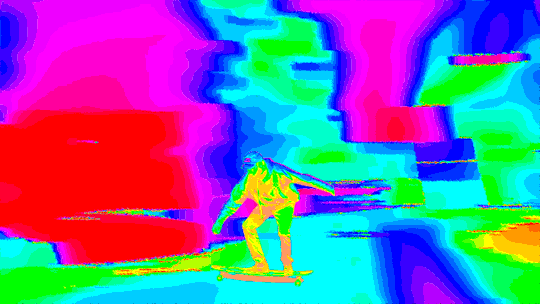
Adam Stokowski twirls in excitement after successfully watching every episode of Care Bears in one sitting.
Kudos.
By PerroPro
#Adam Stokowski#PerroPro#Loadedboards#loaded#boards#longboarding#pirouette#bhangra#all the colors#care bears
87 notes
·
View notes
Photo

Nothing like snapping a selfie next to mini-Old Faithful at the Toronto Board Meeting!
Credit: Adam Stokowski
69 notes
·
View notes
Photo

92 notes
·
View notes
Text
April 11 in Music History
1602 Birth of composer Johann Neukrantz.
1638 Birth of composer Diogo Diaz Melgaz.
1668 Organist and Werkmeister Dietrich Buxtehude becomes organist at the Marienkirche in Lubeck.
1681 Birth of composer Anne Danican Philidor.
1682 Birth of French composer Jean-Joseph Mouret.
1715 Birth of composer John Alcock.
1727 FP of Bach's St. Matthew Passion, at the St. Thomas Church in Leipzig.
1735 Birth of composer Pierre Nicolas La Houssaye.
1769 Birth of composer Johann Georg Lickl.
1770 At a Holy Week service, Leopold, and Wolfgang Mozart hear Allegri's Miserere performed by the Chapel Choir at St. Peter's in Rome.
1775 Birth of composer Charles-François Dumonchau.
1779 Birth of composer Louise Reichardt.
1791 Birth of French composer Marie-Désiré Beaulieu.
1814 FP of Beethoven's Archduke trio, in Vienna. Beethoven at the piano. His contemporary Louis Spohr was there and wrote that the piano was badly out of tune but Beethoven was too deaf to notice.
1816 Birth of German composer Theodore Eisfeld.
1819 Birth of English conductor and pianist Sir Charles Halle.
1838 Birth of composer Joseph Leopold Rockel.
1840 Birth of composer John Conrad Nordqvist.
1840 Birth of French composer Edmond Audran in Lyons.
1852 FP of Adam's "Le Roi des Halles" in Paris.
1859 Birth of composer Basil Harwood.
1874 FP of Brahms' Haydn Variations in US by the Brooklyn Philharmonic, conducted by Theodore Thomas.
1880 Birth of Italian conductor Bernardino Molinari in Rome.
1884 FP of Vincent d'Indy'a symphonic poem La Mort de Wallenstein 'Wallenstein's Death' in Paris.
1888 Opening of the Concertgebouw in Amsterdam. A concert with a 700-piece ensemble. The Concertgebouw Orchestra was founded later in the year.
1889 Birth of German tenor Eduard Lichtenstein in Karlsbad.
1891 FP of Dvorák's Dumky Piano Trio, Op. 90, composer at the piano in Prague.
1901 Birth of composer Theodor Rogalski.
1902 Enrico Caruso makes first operable classical recording in a Milan hotel room
1902 Birth of Italian tenor Enzo de Muro Lomanto.
1903 Birth of Australian baritone Arnold Matters in Adelaide.
1908 Birth of Czech conductor Karel Ancerl.
1910 Birth of composer Jorge Croner de Vasconcelos.
1916 Birth of Argentinian composer Alberto Ginastera in Buenos Aires.
1920 FP of Ravel's Le Tombeau de Couperin in Paris at Pasdeloup Concert in Paris.
1920 FP of O. Respighi's 'Dance of the Gnomes' orchestral, Bernardino Molinari conducting in Rome.
1922 Birth of composer Alexander Raichev.
1926 Birth of English clarinetist Gervase De Peyer in London.
1927 Birth of composer Domenico Guaccero.
1930 FP in US of the staged version of Stravinsky's ballet The Rite of Spring. Was choreographed by Massine and conducted by Stokowski in Philadelphia.
1932 Birth of American composer and record producer Max Schubel.
1934 Birth in Vienna of Opera conductor Henry Holt.
1934 FP of Ernest Bloch's Sacred Service. Schola Cantorum, conducted by the composer in NYC.
1938 Birth of German bass Kurt Moll in Cologne.
1941 Birth of Welsh tenor Arthur Davies in Cadenet.
1941 American naturalization of Austrian-born composer Arnold Schönberg and changes the spelling of his name to Schoenberg. American Works.
1953 Birth of Greek-American composer Dana Dimitri Richardson.
1965 FP of David Amram's Passover opera The Final Ingredient for television in NYC.
1967 FP of Alan Hovhaness' The Holy City in Portland, ME.
1969 Death of Norwegian composer Paul Ludvig Irgens Jensen.
1999 FP of Augusta Read Thomas' Passion Prayers for solo cello and six instruments. Network for New Music, with cellist Scott Kluksdahl in Philadelphia.
4 notes
·
View notes
Photo

Dane Webber on the Comet Marcus Bandy pro model
46 notes
·
View notes
Photo

Loaded Tesseract
8 notes
·
View notes